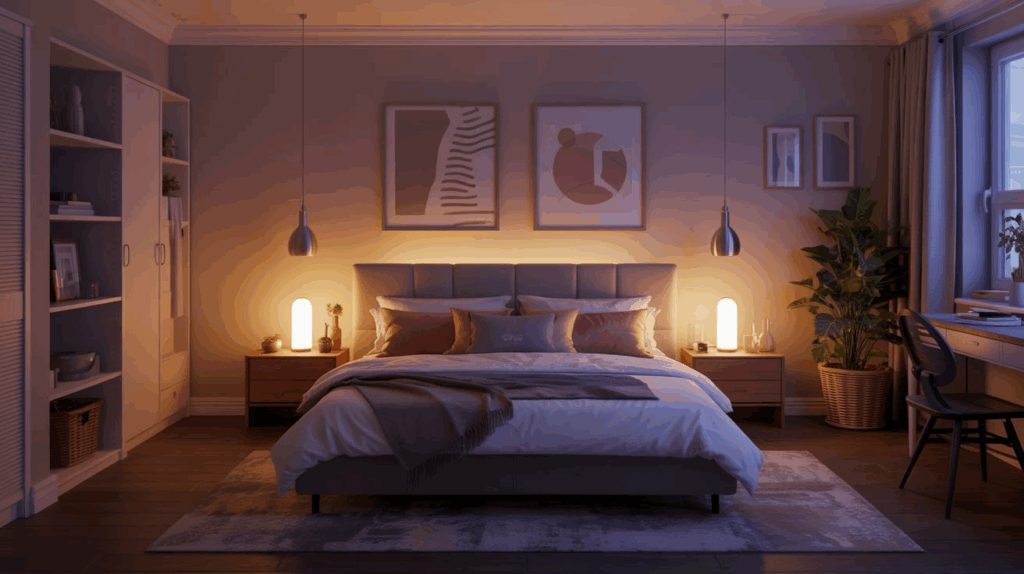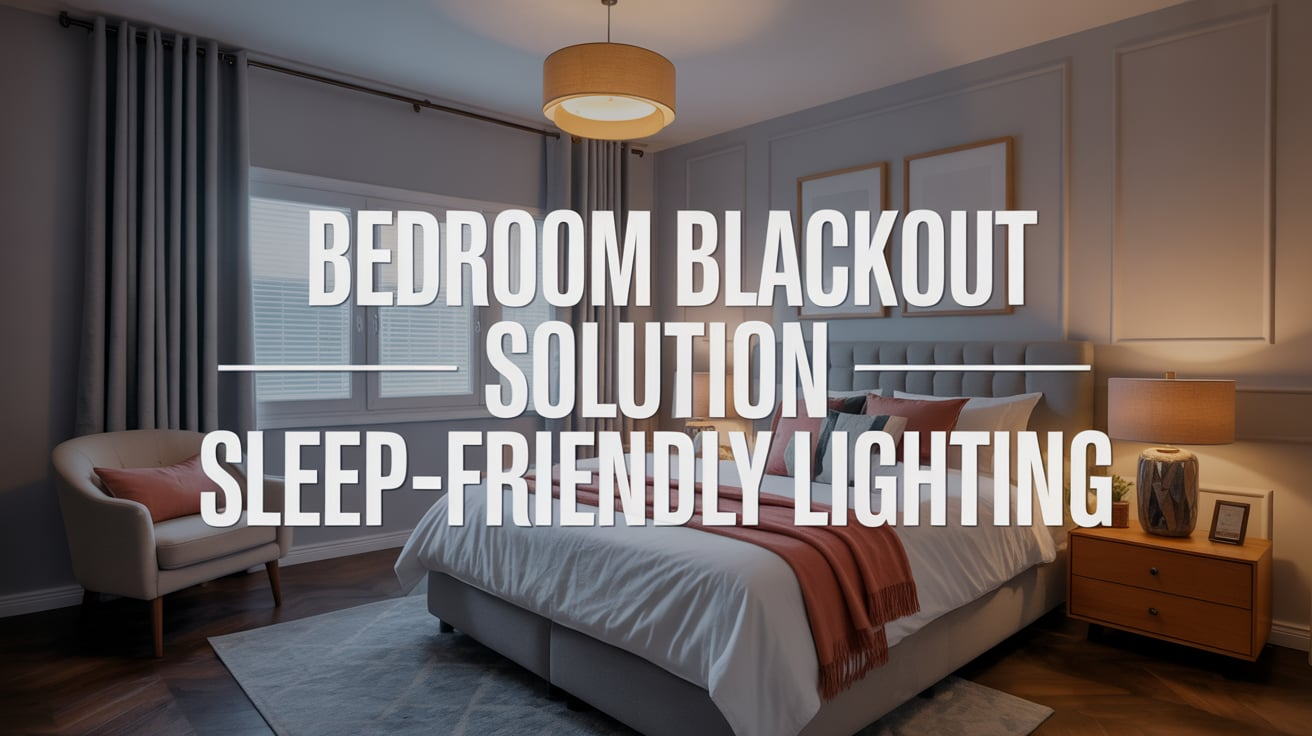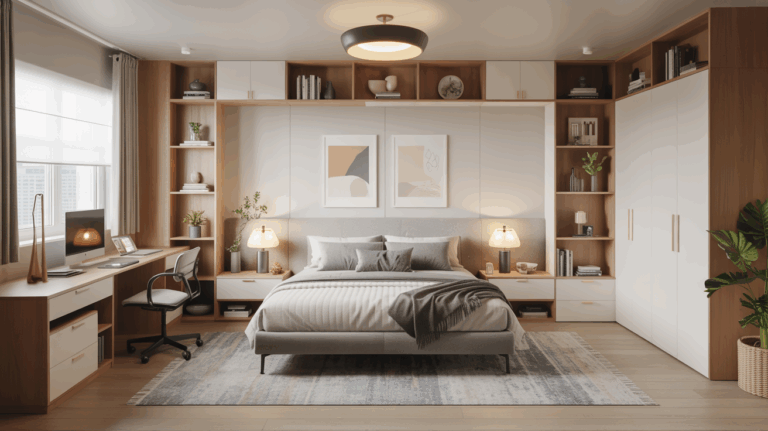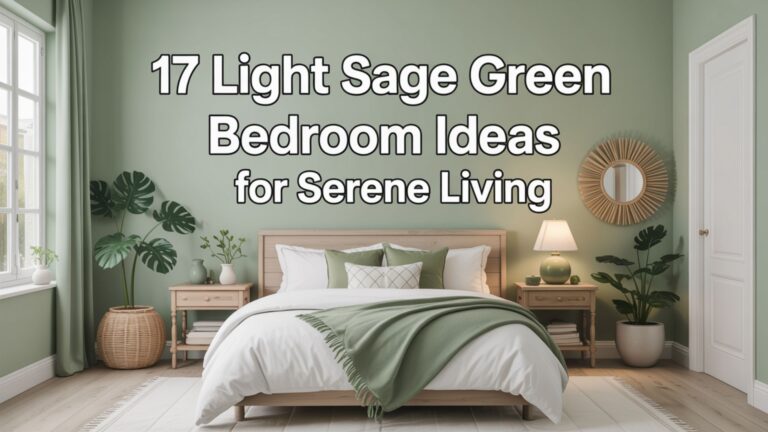The Role of Blackout Solutions and Sleep-Friendly Lighting in Bedrooms
I have been, or can be if you click on a link and make a purchase, compensated via a cash payment, gift, or something else of value for writing this post. As an Amazon Associate, I earn from qualifying purchases. Please read my full Affiliate Disclosure for more information.
Blackout solutions and sleep‑friendly lighting shape when you fall asleep, stay asleep, and wake refreshed by controlling light exposure, color, and timing. You’ll reduce stray brightness, minimize early awakenings, and support melatonin with dim, warm lighting as bedtime nears. Use blackout curtains or films to curb ambient glow, plus gradual lighting shifts that mimic twilight. Morning glare reduction and glare‑free fixtures keep you comfortable. With predictable lighting cues, you’ll reinforce calm routines and steady sleep cycles—continue to learn more.
Key Takeaways
- Blackout solutions minimize stray light, improving sleep onset and continuity by reducing external brightness and nocturnal awakenings.
- Sleep-friendly lighting uses warm tones and gradual dimming to support melatonin production and bedtime wind-down.
- Layered lighting (ambient, task, and accent) helps create predictable cues that align with circadian rhythms.
- Smart controls and sensors automate gradual light shifts, reducing abrupt changes that can disrupt sleep.
- Managing morning glare with diffused light and proper window treatments preserves sleep quality and daytime alertness.
Understanding Sleep-Friendly Lighting Basics

Light color and timing matter for sleep. You’ll learn the basics of lighting design, focusing on how color and timing influence circadian cues. Ambient color choices shape melatonin suppression: cooler hues near daytime encourage alertness, while warmer tones in the evening support relaxation. You’ll want predictable schedules, minimizing abrupt changes in brightness to reduce arousal. Flicker reduction is essential for comfort; steady, low-contrast illumination lowers visual strain and disruption. Aim for lighting that *progresses* gradually from bright to dim, with blue-enriched light avoided in the hour before bed. Ambient color and flicker reduction collectively support consistent, restorative sleep.
How Blackout Solutions Enhance Nighttime Rest
Blackout solutions directly diminish unwanted light intrusion, allowing the brain to receive a clearer signal to enter and maintain sleep. You’ll notice deeper, more consistent cycles when external light is regulated. Practical effects include quicker sleep onset and reduced awakenings due to stray brightness. Use cases focus on interior light sources, streetlight shadows, and morning glow management. Key considerations guarantee reliability and clarity.
- dusk to dawn sensors optimize night-time darkness
- controllable shading minimizes stray leaks
- blackout curtain maintenance sustains performance
- fabric density affects light blocking
- installation positions influence coverage
Managing Morning Light: Strategies to Reduce Glare
Managing morning light can be challenging, but simple, evidence-based adjustments reduce glare and improve morning wake times. You’ll use controlled exposure to dawn awakening cues, aligning your circadian rhythm with outdoor light patterns. Start with window treatments that diffuse or restrict early sunlight, then rotate furniture or desk placement to minimize direct rays at critical eye level during waking moments. Consider glare-reducing screens on devices and matte finishes on nearby surfaces. Light-angle optimization, such as ceiling or wall-mounted fixtures, helps distribute illumination evenly. Reassess at weekly intervals to sustain gains against morning glare without compromising visibility.
Choosing Dimmer, Warmer Lights for the Bedroom
If you choose dimmer, warmer lights, you create a softer bedroom glow that supports circadian rhythms. This approach emphasizes dimming controls and warm color temperatures to reduce blue-light exposure before sleep. By prioritizing dimmer-friendly warmth, you can optimize comfort and timing cues without sacrificing visibility.
Dimmer-friendly Warmth
Dimmer-friendly warmth is about balancing light level with color temperature to support sleep without waking the room. You’ll want to select dimmers and bulbs that emphasize warm hues (around 2700K) and gradual adjustments to avoid abrupt shifts. This approach promotes moonlit serenity and ambient glow without overstimulation.
- Choose dimmers compatible with warm-tint bulbs
- Aim for 20–40% brightness levels before sleep
- Prefer incandescent or warm LEDs, not cool whites
- Pair with blackout curtains to preserve contrast
- Use gradual fade routines as bedtime nears
This empirical setup reduces cortisol spikes and maintains circadian alignment, aiding restorative slumber.
Bedroom Glow Optimization
To optimize bedroom glow, you’ll balance dimmer choices and warmer light to support sleep while preserving visibility for nighttime routines. You’ll prioritize lower color temperatures (2700–3000K) and dimmed luminance to reduce melatonin disruption, then verify practical tasks remain feasible. Measure comfort by eye adaptation after switching lights, noting glare and contrast on surfaces. Choose lighting that supports focused activities without provoking alertness, reserving brighter, cooler options for daytime or hygienic checks. Employ layered lighting—ambient, task, and accent—to sustain bedroom ambiance and enable gradual progression. This approach aligns lighting aesthetics with sleep science for consistent, calm nights.
Smart Lighting and Automation for Sleep Ractors
Smart lighting and automation for sleep ractors focus on reducing blue light exposure and aligning lighting cues with circadian rhythms. You’ll optimize routines with evidence-based controls, ensuring progressions support sleep onset without abrupt changes.
- Use smart switches to dim gradually as bedtime nears
- Program color temperature to shift toward warm tones after dusk
- Schedule lights to mimic natural sunset and sunrise cues
- Employ voice control for quick, hands-free adjustments
- Integrate motion sensing to avoid unnecessary illumination during deep sleep
These practices promote consistency, improve sleep latency, and align lighting with circadian biology.
Window Treatments: Curtains, Shades, and Films
Curtain color affects how much light is reflected into a room, influencing perceived brightness and heat load. Shades that block light determine sleep impact and daily wake times, with higher blocking correlating to deeper sleep. Window films can alter energy use by changing interior heat gain, so consider the combined effects on comfort, glare, and block percentage when selecting treatments.
Curtain Color Reflectance
Choosing curtain color with appropriate reflectance directly affects room lighting and perceived brightness. You’ll optimize sleep-friendly ambiance by matching curtain fabric and color reflectance to your existing light sources, avoiding glare while preserving natural cues. Higher reflectance fabrics brighten spaces; darker tones absorb light to reduce glare. Consider contrast with wall color and furniture to maintain balance without oversaturation. This empirical approach prioritizes measurable effects over guesswork, guiding material choice and placement for consistent outcomes.
- curtain fabric choices and reflectance levels
- effect on daylight diffusion
- glare and contrast management
- wall and furniture coordination
- testing light outcomes with measurements
Shade Light Blocking
Shade light blocking is about selecting window treatments—curtains, shades, or films—that effectively reduce daylight and artificial glare while preserving essential cues for circadian regulation. You assess how fabrics, opacity, and layering influence visual comfort and sleep onset. Light-blocking options vary in transmission, with heavier drapes lowering outdoor illumination and glare more reliably than light-filtering options. Consider fit to window frames and potential gaps that undermine performance. Balance blackout potential with morning light cues to maintain circadian alignment. Be mindful of light pollution and outdoor illumination when choosing coverings to avoid unintended nighttime spill.
Film Energy Impact
Could window films meaningfully cut energy use without compromising daylight and circadian cues? Yes, when films reduce solar gain while maintaining visible light. You’ll notice lower cooling loads and steadier interior temperatures, especially in sunlit rooms. Films tailored to color temperature can preserve daylight quality and reduce glare, supporting steady circadian cues. Pair with appropriate lighting fixtures to ensure tasks stay bright without overlighting. Consider film categories that balance energy savings with occupant comfort, and test for transparency versus shading needs.
- Lower cooling demand without sacrificing daylight
- Select films by solar gain and color temperature
- Minimize glare for writing and reading
- Pair with efficient lighting fixtures
- Validate comfort with real-world measurements
Privacy, Comfort, and Light Control Trade-offs
Balancing privacy, comfort, and light control requires clear trade-offs: increasing privacy usually limits ambient light and view, while maximizing comfort can reduce the precision of glare control. You evaluate window coverings, wall color, and surface textures to minimize glow without erasing visibility. Privacy concerns emerge when screens or blinds diminish natural cues, yet they can lower bedtime disruption from outside activity. Comfort favors softer luminance distributions, sometimes at the expense of high-contrast depth. Aesthetic considerations influence material choice and mounting, shaping user experience. In practice, you quantify glare, diffusion, and seam exposure to optimize both privacy and comfort.
Creating a Calm Evening Routine With Lighting
Creating a calm evening routine with lighting hinges on predictable, layered cues that guide the body toward wind-down. You’ll align light color, intensity, and timing to promote physiological twilight signaling and stable melatonin release, while avoiding abrupt shifts.
- Use warmer hues and dimming steps as bedtime nears
- Pair lighting with quiet, predictable schedules
- Integrate nighttime aromatherapy for subtle cues
- Introduce sleep-inducing soundscapes at a consistent hour
- Limit bright, blue-enriched light after early evening
This approach supports sustained calm, reduces arousal, and enhances sleep readiness through empirical, repeatable patterns.
Practical Setup: Room-by-Room Lighting Plans
A room-by-room lighting plan should translate your overall goals into specific, repeatable cues that align with daily routines. In the bedroom, place a dim, adjustable main light to support wind-down and a cooler task light for reading before bed. Use warm, low-intensity fixtures near the bed to preserve sleep quality. Doorways and closets deserve motion-activated lighting to minimize wakefulness during night visits. Consider layered lighting: ambient, task, and accent elements that reinforce your intended sequence. Confirm wiring and switches are accessible, and seats and desks reflect purposeful lighting placement. This approach cultivates bedroom ambiance and practical, repeatable routines.
Conclusion
In your bedroom, lighting should align with your circadian rhythm and comfort needs. Use blackout solutions to minimize nocturnal disturbances, and choose dimmer, warmer lights to encourage sleep onset. Control morning glare with smart automation that fades in gradually. Balance privacy with light control through thoughtful curtains or films, and create a calming routine that signals winding down. Practical, room-by-room setups help maintain consistency, reduce awakenings, and promote deeper, more restorative sleep.






